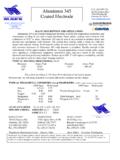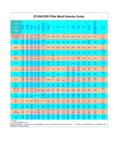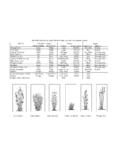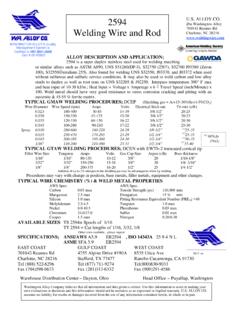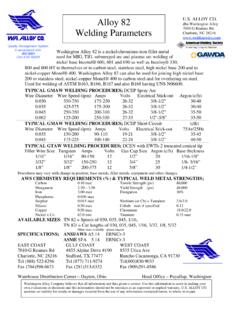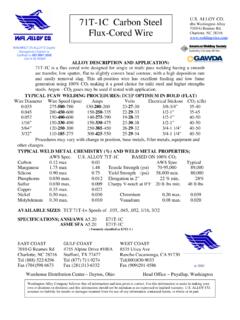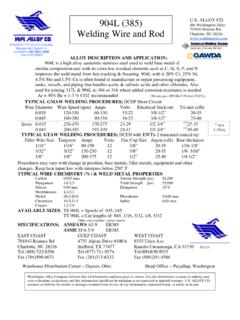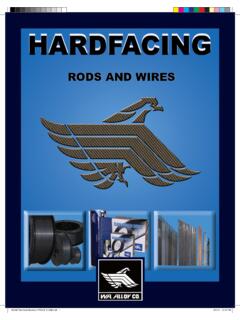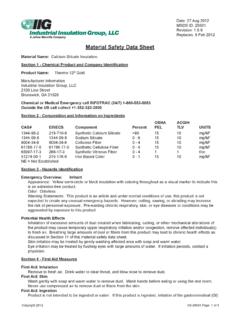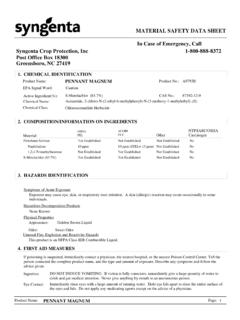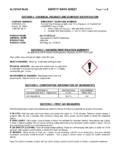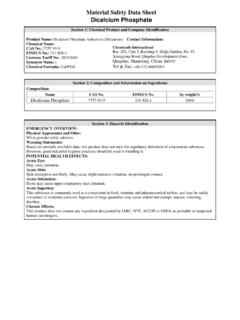Transcription of MATERIAL SAFETY DATA SHEET (MSDS)
1 msds NO:TUNGSTEN ELECTRODEREVISED11-2010 MATERIAL SAFETY data SHEET ( msds )For Welding Consumables and Related ProductsConforms to OSHA Hazard Communication Standard 29 CFR Must Be Consulted for Specific RequirementsSECTION I IDENTIFICATIONM anufacturer/Supplier: Washington Alloy CompanyTelephone No: 704-598-1325 Address: 7010-G Reames Road, Charlotte, NC 28216 Emergency No: 704-598-1325 Trade Name:Specification:Classification:AWSC olor IdPure Tungsten,2% Ceriated Tungsten1% Lanthanated Lanthanated Tungsten2% Lanthanated Tungsten1% Thoriated Tungsten2% Thoriated TungstenZirconated TungstenZirconated Tungsten Zr-8 AWS (ISO 6848)EWP(WP)EWCe-2(WCe20)EWLa-1(WLa10) (WLa15)EWLa-2(WLa20)EWTh-1(WTh10)EWTh-2( WTh20)EWZr-1(WZr3)EWZr-8(WZr8)Green(form erlyOrange) GreyBlackGoldBlueYellowRedBrownWhiteSECT ION IIHAZARDOUS INGREDIENTS/Identity InformationIMPORTANT:This section covers the materials fromwhich the product is manufactured.
2 The fumes and gases product during weldingwith thenormal use of this product are covered under Section term HAZARDOUS MATERIALS should be interpreted as a term required anddefined in OSHA HAZARD COMMUNICATIONS STANDARD 29 CFR however the use of this term does not necessarily implythe existence of any Limit (mg/m3)Ingredients of The ProductCAS PELACGIH TLVT ungsten (W)7440-33 , ** , **Thorium Dioxide(ThO2)(1)1314-20 -1 Zirconium Oxide (ZrO2)1314-23 , ** , **Cerium Dioxide(CeO2)1345-13 -7 Lanthanum Dioxide( LaO2)1312-81 -8 Chemical Composition Weight %WCeO2 LaO2 ThO2 ZrO2 Pure (Min.)2% Ceriated Lanthanated Lanthanated Lanthanated Thoriated Thoriated TungstenZr elements or ingredients may be present but in quantities much less than 1%.
3 (1)Subject to reporting requirements of Section 313 of the Emergency Planningand Community Right-To-Know Act of 1986 and 40 CFR 370 and 372;(Resp) = Respiratory/ Respiration: Welding and cutting of products that containChromium may produce hexavalent chromium and YOU should read and follow OSHA s final rules Fed Register #:71:10099-10385 dated 02-28 SAFETY and Health Administration 29 CFR Permissible Exposure Limit (PEL).American Conference of Governmental IndustrialHygienists (ACGIH) Threshold Limit Value (TLV[R]).*Ceiling Limit**Short Term Exposure LimitImpurities = III- PHYSICAL DATAAs shipped these are solid rods that are nonflammable, non-explosive, non-reactive and non hazardous that are bare metal silver-gray hard andbrittle electrodesSECTION IV FIRE AND EXPLOSION HAZARD DATANon-Flammable: Welding arc and sparks can ignite divided powers are flammable and may ignite if exposed to staticelectric referenced in on page 2 SECTION V REACTIVITY & STABILITY DATAH azardous Decomposition ProductsWelding fumes and gases cannot be classified simply.
4 The composition and quantity of these fumes and gases are dependent upon the metalbeing welded, the procedures followed and the electrodes should be aware that the composition and quantity of fumes and gases towhich they may be exposed, are influenced by: coatingswhich may be present on the metal being welded (such as paint, plating, or galvanizing),the number of welders in operation and the volumeof the work area, the quality and amount of ventilation, the position of the welder s head withrespect to the fume plume, as well as thepresence of contaminants in the atmosphere (such as chlorinated hydrocarbon vapors from cleaning anddegreasing procedure).
5 When theelectrode is consumed, the fumes and gas decomposition products generated are different in percent and formfrom the ingredients listed inSection II, The composition of these fumes and gases are the concerning matter and not the composition of theelectrode products include those originating from the volatilization, reaction, or oxidation of the ingredients shown inSection II, plusthose from the base metal,coating and the other factors noted expected fume constituents of this productmayinclude: Complex oxides of aluminum, iron, manganese, silicon, sodium,potassium, nickel, calcium, and copper. Fluorides will also be reaction products may include carbon monoxide and carbon dioxideOzone and nitrogen oxides may be formed by the radiation from Thorium oxides may undergo radioactive method of determining the composition and quantity of thefumes and gases to which the workers are exposed is to take an air samplefrom inside the welder s helmet while worn or within the worker sbreathing zone.
6 See ANSI/AWS publication available from theAmerican Welding Society 550 LeJeuneRoad, Miami, Florida : As shipped these products are VI ENTRY DATAC ommon Entry:During the welding processes inhalation of welding fumes may give the most common route of over exposureas well as thedust from the grindingprocess. Contact with skin, eyes, ingestion or injection should not be a source for exposure with proper VII Threshold Limit ValueThe ACGIH recommended general limit for welding fume NOC (Not otherwise classified) is 5 mg/m3. ACGIH-1985 prefacestates: The TLC-TWA should be used as guides in the control of health hazards and should not be used as fine lines between safe and dangerousconcentrations.
7 Read all other sections for specific fume constituents, which may modify this VIII HEALTH HAZARD DATAE ffects of Overexposure:Inhalation of welding fumes and gases can be dangerous to your health. Short-term (acute) overexposure to weldingfumes may result in discomfort such as dizziness, nausea, or dryness or irritationof nose, throat, or eyes. Chromium (VI) compounds present inthe fume may cause abdominal pain, diarrhea, muscular weakness and convulsions. Continued inhalation could cause loss of consciousness anddeath. Chromium (VI) compounds present in the fume may cause severe irritation of the bronchial tubes and lungs.
8 Ingesting Chromium (VI)salts may cause injury of death. Chromium (VI) compounds may burn eyes. Chromium compounds may cause allergic reactions in some oxides present in the fume may cause tightness around the chest, fever and allergic reactions in some people. Long-term (chronic) over-exposure to welding fumes can lead to siderosis (iron deposits in lung) and is believed to affect pulmonary function. Repetitive exposure tofluoride fumes and/or gases may cause excessive calcification of the bones and ligaments of the ribs, pelvis and spinal column. Constantinhalation of chromium (VI) compounds may cause an ulceration and perforation of the nasal septum as well as liver and kidney overexposure to nickel oxides may lead to lung fibrosis or pneumoconiosis.
9 Workers exposed to chromium (VI) compounds and/ornickel oxides have a higher incidence of lung and nasal cancers. Chromium and nickel compounds are on the IARC (International Agency forResearch of Cancer) list as posing a carcinogenic risk to humans. Arc Rays can injure eyes and burn skin. Electric shock can California Proposition 65 listed in Section X. Special precautions must be taken duringthe grinding, machining or weld working when usingelectrodes containing Thorium due to the generation of dust or IX-Emergency and First Aid ProceduresRemove to fresh Air. Call for medical assistance. Use first aid procedures recommendedby the American Red Cross.
10 If breathing is difficult ornot breathing give oxygen or use CPR (cardiopulmonary resuscitation) by trained personnel. Consult a physician if irritation of the eyes andskin or flash burns develops after X- TOXICOLOGICAL INFORMATIONA cute toxicity:Overexposure or inhalation of large amounts of welding fumes may cause symptoms such as metal fume fever, dizziness, nausea,dryness and irritation of your nose, throat or eyes as well as other lung :Overexposureor prolonged inhalation of large amounts of welding fumes with chromium compounds may cause cancer. Otheroverexposureor prolonged inhalation of large amounts of welding fumes symptoms related may include damage to the central nervous system,respiratory system, skin and could affect organs such as pancreas and liverCarcinogenicityOSHA (29 CFR ) lists Nickel and Chromium as possible oxide has been identified as acarcinogen by NTP, IARC and Proposition 65 Thorium oxide is listed onCalifornia Proposition 65 These productsmaycontain or produces chemicals known to the State of California to cause cancer, and/or birth defects (or other reproductiveharm).

